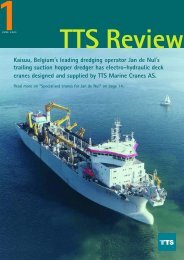Winch bollard design aids safe mooring operations - TTS Group ASA
Winch bollard design aids safe mooring operations - TTS Group ASA
Winch bollard design aids safe mooring operations - TTS Group ASA
Create successful ePaper yourself
Turn your PDF publications into a flip-book with our unique Google optimized e-Paper software.
TECHNOLOGY - BOLLARDS<br />
<strong>Winch</strong> <strong>bollard</strong> <strong>design</strong><br />
<strong>aids</strong> <strong>safe</strong> <strong>mooring</strong><br />
<strong>operations</strong><br />
Following on from the UK P&I Club’s article on the dangers of <strong>mooring</strong> <strong>operations</strong><br />
(see TA�KEROperator, �ovember/December, page 8), <strong>TTS</strong> Marine has advised us<br />
of its new patented <strong>TTS</strong> <strong>Winch</strong> Bollard, which the company claims is much <strong>safe</strong>r<br />
and easier to use than the more conventional systems currently available.<br />
The new equipment can replace<br />
<strong>mooring</strong> winches, capstans,<br />
warping drums and <strong>bollard</strong>s<br />
normally used for <strong>mooring</strong>,<br />
<strong>TTS</strong> said. Tests have shown that the new<br />
system’s <strong>mooring</strong> and tightening of slack<br />
rope <strong>operations</strong> can easily be carried out<br />
by one person instead of the usual two<br />
seafarers, the company claimed.<br />
The company said that its <strong>Winch</strong> Bollard<br />
contributes to <strong>safe</strong> <strong>mooring</strong> <strong>operations</strong>, as<br />
it reduces risks of injuries during <strong>mooring</strong><br />
and rope disruption caused by too high<br />
rope tension on the fixed <strong>bollard</strong>, or with<br />
slack <strong>mooring</strong>s. By fitting the system, a<br />
saving on deck space can also be made as<br />
there is less equipment needed for <strong>mooring</strong><br />
<strong>operations</strong>. It is available both in hydraulic<br />
The stern<br />
section of one<br />
of the Vela<br />
VLCCs showing<br />
<strong>TTS</strong>’ <strong>Winch</strong><br />
Bollards in<br />
place.<br />
January/February 2011 � TANKEROperator 39
TECHNOLOGY - BOLLARDS<br />
40<br />
<strong>Winch</strong> Bollard basic<br />
features<br />
� Compact, clean and water resistant<br />
<strong>design</strong>.<br />
� Direct <strong>mooring</strong> without use of<br />
stoppers.<br />
� One man operated.<br />
� Optimal and <strong>safe</strong> control during<br />
<strong>mooring</strong> by means of a control<br />
stand with a foot pedal, integrated<br />
emergency stop and a flexible<br />
cable connection.<br />
� Easy controllable fail <strong>safe</strong> brakes.<br />
� Stepless speed control with high<br />
light line speed.<br />
� Automatically reduction of line<br />
speed when the load is increased.<br />
� Low noise during operation.<br />
� Self-lubricated bearings for low<br />
maintenance.<br />
Standard equipment<br />
� Complete winch <strong>bollard</strong> with<br />
necessary equipment to ensure<br />
<strong>safe</strong> operation.<br />
� Frequency converter with control<br />
unit (electrical version).<br />
� Prepared for connection to the<br />
vessel’s ring line system or HPU<br />
(hydraulic version).<br />
� Foundation prepared for welding<br />
to the vessel’s main deck structure.<br />
� Entire steel structure made of<br />
certified steel and sand blasted to<br />
Sa 2.5 prior to painting.<br />
� Exterior paintwork: top quality,<br />
two-component epoxy/acrylic<br />
paint of highest marine standard.<br />
Colour according to owner’s<br />
choice.<br />
� Full set of operating manuals and<br />
spare parts list.<br />
� Optional pipe hatch; rope; storage<br />
drums; HPU; radio control etc, on<br />
request.<br />
The patented <strong>TTS</strong> <strong>Winch</strong> Bollard is a <strong>safe</strong> and easy, one-man operated<br />
<strong>mooring</strong> device that avoids the human wear and tear associated with standard<br />
<strong>mooring</strong> procedures. Rope tension is handled mechanically leaving the operator<br />
to simply oversee the securing process. The device is <strong>design</strong>ed to replace<br />
capstans, wrapping drums and <strong>bollard</strong>s used in conventional <strong>mooring</strong>.<br />
Shipboard handling excellence<br />
Call <strong>TTS</strong> Marine: +47 38 04 95 00 www.ttsgroup.com<br />
and electric versions.<br />
<strong>TTS</strong> said that the Norwegian Maritime<br />
Directorate (NMD) had shown great interest<br />
in the positive results of <strong>mooring</strong> <strong>safe</strong>ty<br />
when using the <strong>Winch</strong> Bollard.<br />
Feedback from the two vessels on<br />
which WB250 type was mounted was<br />
claimed to be very positive. A testimony<br />
from one of the vessel’s owners said; “We<br />
have found the winch <strong>bollard</strong>s to be very<br />
useful.<br />
In Scottish waters where we have a<br />
large tidal range, ships’ <strong>mooring</strong>s require<br />
to be tended more frequently. Using <strong>TTS</strong><br />
<strong>Winch</strong> Bollards means tending rope<br />
s during the night can be a one man<br />
operation”.<br />
Eight <strong>Winch</strong> Bollards were recently<br />
installed on board four large tankers<br />
managed by Vela. They are all installed on<br />
the tankers’ quarterdecks.<br />
There are three different size ranges<br />
available –<br />
� WB250 with a 4 tonne pull force.<br />
� WB400 with a 8 tonne pull force.<br />
� WB500 with a 15 tonne pull force. TO<br />
TANKEROperator � January/February 2011





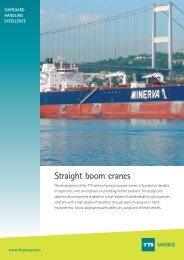
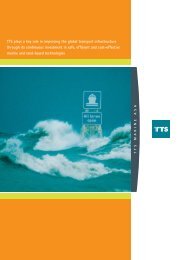
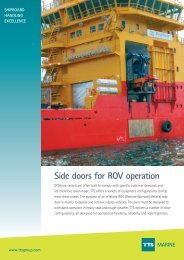
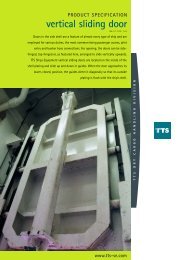
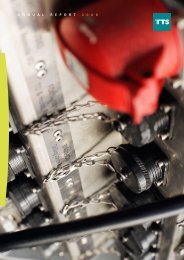


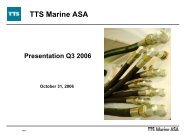
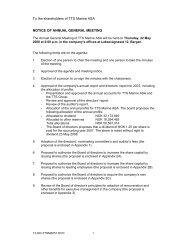
![2012.MasterPresentation_final [Compatibility Mode] - TTS Group ASA](https://img.yumpu.com/4612021/1/190x146/2012masterpresentation-final-compatibility-mode-tts-group-asa.jpg?quality=85)
